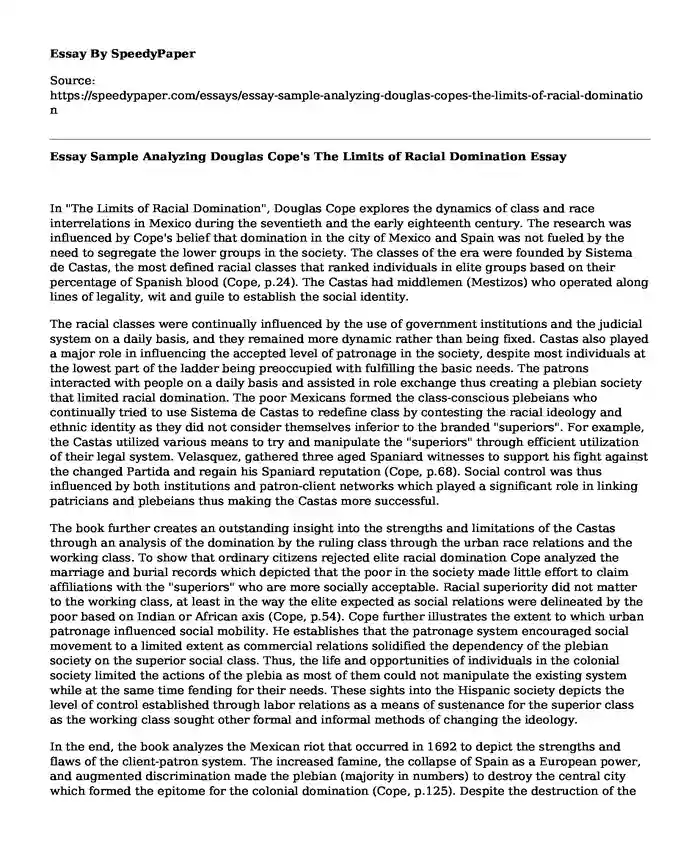
| Type of paper: | Book review |
| Categories: | Race Discrimination |
| Pages: | 4 |
| Wordcount: | 851 words |
In "The Limits of Racial Domination", Douglas Cope explores the dynamics of class and race interrelations in Mexico during the seventieth and the early eighteenth century. The research was influenced by Cope's belief that domination in the city of Mexico and Spain was not fueled by the need to segregate the lower groups in the society. The classes of the era were founded by Sistema de Castas, the most defined racial classes that ranked individuals in elite groups based on their percentage of Spanish blood (Cope, p.24). The Castas had middlemen (Mestizos) who operated along lines of legality, wit and guile to establish the social identity.
The racial classes were continually influenced by the use of government institutions and the judicial system on a daily basis, and they remained more dynamic rather than being fixed. Castas also played a major role in influencing the accepted level of patronage in the society, despite most individuals at the lowest part of the ladder being preoccupied with fulfilling the basic needs. The patrons interacted with people on a daily basis and assisted in role exchange thus creating a plebian society that limited racial domination. The poor Mexicans formed the class-conscious plebeians who continually tried to use Sistema de Castas to redefine class by contesting the racial ideology and ethnic identity as they did not consider themselves inferior to the branded "superiors". For example, the Castas utilized various means to try and manipulate the "superiors" through efficient utilization of their legal system. Velasquez, gathered three aged Spaniard witnesses to support his fight against the changed Partida and regain his Spaniard reputation (Cope, p.68). Social control was thus influenced by both institutions and patron-client networks which played a significant role in linking patricians and plebeians thus making the Castas more successful.
The book further creates an outstanding insight into the strengths and limitations of the Castas through an analysis of the domination by the ruling class through the urban race relations and the working class. To show that ordinary citizens rejected elite racial domination Cope analyzed the marriage and burial records which depicted that the poor in the society made little effort to claim affiliations with the "superiors" who are more socially acceptable. Racial superiority did not matter to the working class, at least in the way the elite expected as social relations were delineated by the poor based on Indian or African axis (Cope, p.54). Cope further illustrates the extent to which urban patronage influenced social mobility. He establishes that the patronage system encouraged social movement to a limited extent as commercial relations solidified the dependency of the plebian society on the superior social class. Thus, the life and opportunities of individuals in the colonial society limited the actions of the plebia as most of them could not manipulate the existing system while at the same time fending for their needs. These sights into the Hispanic society depicts the level of control established through labor relations as a means of sustenance for the superior class as the working class sought other formal and informal methods of changing the ideology.
In the end, the book analyzes the Mexican riot that occurred in 1692 to depict the strengths and flaws of the client-patron system. The increased famine, the collapse of Spain as a European power, and augmented discrimination made the plebian (majority in numbers) to destroy the central city which formed the epitome for the colonial domination (Cope, p.125). Despite the destruction of the central city, the patronage system became even stronger as Mexico's ruling class became more monolithic, thus forcing most of the plebia to bargain for the few chances controlled by social superiors.
"The Limits of Racial Domination" focuses on Mexico City as the city formed the most diverse Spaniard city in New Spain with relevant and vast documentation to support the research. Some of the wide variety of sources used by Cope entails inquisition records, notarial records, ecclesiastical documents, court cases, parish registers, and other civil records that aimed at challenging the view of Castas as a segregation system that was dominated by the elite while the rest of the society alienated. Previous research such as the works of Irene Silverblatt, Inga Clendinnen, and Steve Stern on the subordinate groups of Latin America formed the foundation of Cope's research. At instances, the data is forced into one-dimensional analysis, thus obscuring the intricacies and social gradation to support evidence needed to support the author's thesis. Consequently, Cope's interpretations may provoke debates interested in creating an understanding of the relationships between the socially dominant groups and the less dominant and how dominance is sustained despite the possibility of interracial relationships.
The book is an excellent read for cultural studies and historians focused on the development of social relations and the sustenance of dominance by the superior class. The book is also ideal for race relation studies under a hemispheric context and urban studies with a focus on the urban poor during the colonial era.
Work Cited
Cope, R. Douglas. The limits of racial domination: Plebeian society in colonial Mexico City, 1660-1720. University of Wisconsin Press, 1994.
Cite this page
Essay Sample Analyzing Douglas Cope's The Limits of Racial Domination. (2022, Sep 09). Retrieved from https://speedypaper.com/essays/essay-sample-analyzing-douglas-copes-the-limits-of-racial-domination
Request Removal
If you are the original author of this essay and no longer wish to have it published on the SpeedyPaper website, please click below to request its removal:
- Statement of Interest Essay Sample: Ryerson's Public Policy and Administration Ph.D. Program
- Icelandic Freeze, Business Ethics Essay Sample
- Literary Analysis Essay Sample: The Themes in "Gravel" by Alice Munro
- Focusing on the How of Violence - Article Review Essay Sample
- Essay Example - Information Is Power
- Essay Sample on Post-Traumatic Stress Disorder: Surviving a School Shooting
- What is database performance tuning? Paper Example
Popular categories




